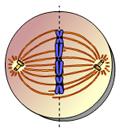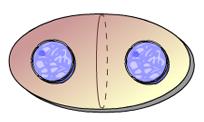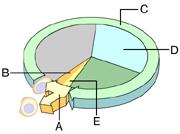look at items
1&2
Which of the following statements are true of cytokinesis in plant cells? Select the two that apply.
Vesicles from the Golgi apparatus move along microtubules, coalesce at the plane of cell division, and form a cell plate.
The cell plate consists of the plasma membrane and cell wall that will eventually separate the two daughter cells.
Nucleoli are present during _____.
interphase
Cytokinesis often, but not always, accompanies _____.
telophase
Chromosomes become visible during _____.
Prophase
Centromeres divide and sister chromatids become full-fledged chromosomes during _____.
anaphase note: During anaphase, sister chromatids separate and daughter chromosomes migrate to opposite poles.
Spindle fibers attach to kinetochores during _____.
prometaphase

Click on the art to see an animation. This animation illustrates the events of _____.
anaphase

Click on the art to see an animation. This animation illustrates the events of _____.
cytokinesis as it occurs in animal cells
During prophase a homologous pair of chromosomes consists of _____.
two chromosomes and four chromatids

Which of these phases encompasses all of the stages of mitosis?
E
During _____ both the contents of the nucleus and the cytoplasm are divided.
the mitotic phase
During _____ the cell grows and replicates both its organelles and its chromosomes.
interphase
Why do some species employ both mitosis and meiosis, whereas other species use only mitosis?
They need both if they are producing animal gametes.
A human bone marrow cell, in prophase of mitosis, contains 46 chromosomes. How many chromatids does it contain?
92
Why is it difficult to observe individual chromosomes with a light microscope during interphase?
They have uncoiled to form long, thin strands.
Starting with a fertilized egg (zygote), a series of five cell divisions would produce an early embryo with how many cells?
32
Which of the following is true of kinetochores?
They are sites at which microtubules attach to chromosomes.
Which of the following correctly matches a phase of the cell cycle with its description?
G1: follows cell division
In some organisms, such as certain fungi and algae, cells undergo the cell cycle repeatedly without subsequently undergoing cytokinesis. What would result from this?
large cells containing many nuclei
Which of the following is found in binary fission but not in mitosis?
Duplicated chromosomes attach to the plasma membrane.
Cytochalasin B is a chemical that disrupts microfilament formation. How would this interfere with cell division?
cleavage
Through a microscope, you can see a cell plate beginning to develop across the middle of a cell and nuclei forming on either side of the cell plate. This cell is most likely
a plant cell in the process of cytokinesis.
Which of these is NOT a carcinogen?
UV light
fat
testosterone
cigarette smoke
all of the above are carcinogens
_____ is a carcinogen that promotes colon cancer.
fat
Which of the following is a function of the S phase in the cell cycle?
The synthesis of sister chromatids
The copying of chromosomes occurs during which of the following phases of the cell cycle?
S phase
For the first several divisions of early frog embryos, cells proceed directly from the M phase to the S phase and back to M without gaps. Which of the following is likely to be true about dividing cells in early frog embryos?
The cells get smaller with each generation.
True or false? The M phase is characterized by the replication and division of a cell's chromosomes.
False
If an organism normally has 34 chromosomes, how many molecules of DNA should there be in the G1 phase of the cell cycle?
34
Which of the following events would cause the cell cycle to arrest?
Poor nutrient conditions
Cells will usually divide if they receive the proper signal at a checkpoint in which phase of the cell cycle?
G1
Which of the following is true of benign tumors, but not malignant tumors?
They remain confined to their original site
Prior to this new technique, how were mice given cancerous tumors?
The tumors were implanted under the skin.
You are an oncologist. A patient presents with advanced prostate cancer and you follow standard protocol. What do you do?
The patient is treated with chemical castration.
You are an endocrinologist studying new treatments for prostate cancer. You have a patient with an unusually large level of dihydrotestosterone. Which of the following is true?
Your patient's cancer has become resistant to the standard treatment.
Which of the following is true regarding prostate cancer cells?
They can activate and inactivate certain genes.
Your uncle has prostate cancer. Which of the following indicates improvement in his condition?
A decreasing PSA.
An environmental substance that is known to cause cancer is called a what?
carcinogen
Radiation emitted from which of the following two sources are most alike?
microwaves and cellphones
You are trying to discover if the pesticide atrazine is a mutagen. Where are you looking for mutations?
DNA
Which of the following is true?
Cancer-causing substances work in many different ways.
Which of the following best summarizes current scientific opinion regarding cellphones and brain cancer?
While most studies indicate that cellphones do not cause brain cancer, more research needs to be done as cellphone use increases.
Through a microscope, you can see a cell plate beginning to develop across the middle of a cell and nuclei forming on either side of the cell plate. This cell is most likely
a plant cell in the process of cytokinesis.
Vinblastine is a standard chemotherapeutic drug used to treat cancer. Because it interferes with the assembly of micro-tubules, its effectiveness must be related to
disruption of mitotic spindle formation.
One difference between cancer cells and normal cells is that cancer cells
continue to divide even when they are tightly packed together.
The decline of MPF activity at the end of mitosis is due to
the degradation of cyclin.
In the cells of some organisms, mitosis occurs without cytoki-nesis. This will result in
cells with more than one nucleus.
Which of the following does not occur during mitosis?
replication of the DNA
A particular cell has half as much DNA as some other cells in a mitotically active tissue. The cell in question is most likely in
G1
The drug cytochalasin B blocks the function of actin. Which of the following aspects of the animal cell cycle would be most disrupted by cytochalasin B?
cleavage furrow formation and cytokinesis
If a eukaryotic cell is in the G1 phase of the cell cycle, which statement about the cell’s chromosomes must be correct?
Each chromosome is made of a complex of DNA and associated proteins.
Which statement provides the best description of the interphase portion of the cell cycle?
During interphase, a cell is metabolically active.
What is true of all cancers?
They have escaped normal cell cycle controls.
How do cancer cells differ from normal cells?
Cancer cells may be immortal.
The cell cycle control systems of cancer cells differ from those of normal cells. Select the best explanation for this fact.
Genetic changes alter the function of the cancer cell’s protein products.